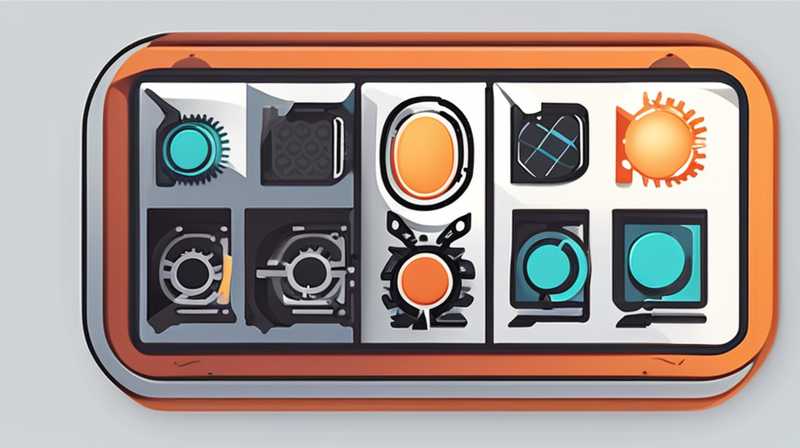
How to use manual gear of solar light
Utilizing the manual gear of solar lights effectively requires understanding its mechanisms and operational processes. 1. Familiarity with the mechanism is essential for optimal performance, 2. Assessment of location affects light efficiency, 3. Routine maintenance enhances longevity, 4. Adjustments can yield better illumination outcomes. Among these, familiarity with the mechanism is vital as it ensures the user can adjust settings appropriately depending on the environment and needs. The manual gears often provide settings for varying light intensities or modes that can adapt to different usage scenarios, thereby maximizing energy efficiency and extending the lifespan of the solar device.
1. UNDERSTANDING SOLAR LIGHT TECHNOLOGY
Solar lights harness sunlight, converting it into electricity. The key components include photovoltaic panels, batteries, and LEDs. Photovoltaic panels absorb sunlight and convert it into electrical energy, which gets stored in batteries. During dusk, the light sensors activate the LEDs, providing illumination based on the energy stored.
The reliability of solar lights heavily relies on their geographic placement. Optimal positioning ensures adequate sunlight capture. For instance, placing the light in a shady area can lead to insufficient energy absorption, resulting in dim or non-operational lighting systems. Therefore, assessing the landscape and ensuring direct exposure to sunlight for most of the day is critical for effective functionality.
2. MANUAL OPERATION MODES
The manual gear typically includes various settings adjusted by the user based on specific requirements. Many solar lights come equipped with dimmer switches, timers, or different light modes. Understanding these options can significantly affect illumination quality and energy consumption.
For instance, a lighting system with dim settings can adjust brightness according to the surrounding conditions, whether bright or dim. Using lower brightness modes during the lighter hours can preserve battery life for the darker quarters of the night, maximizing efficiency. Similarly, timers can automate operation windows, allowing users to set the light according to their routines or specific events.
3. PLACEMENT STRATEGIES
Effective placement of solar lights mandates a strategic approach. Choosing suitable locations ensures maximum sunlight exposure and operational efficiency. Areas with minimal obstruction, like tall trees or structures, provide better results. Spaces should be assessed throughout the day to see how the sunlight behaves and how it affects each potential lighting position.
It is also critical to consider the intended purpose of the solar lights. For example, if the objective is to illuminate pathways or gardens, placing the lights at regular intervals enhances visibility while promoting safety. However, if the goal is aesthetics, positioning the lights to highlight architectural features or plants can create a calming ambiance while achieving illumination.
4. MAINTENANCE PRACTICES
Regular maintenance of solar lights is paramount for longevity and optimal performance. Cleaning the photovoltaic panels is necessary to ensure efficiency. Dust, dirt, and debris can accumulate on the surface, blocking sunlight absorption. Periodic cleaning with a damp cloth, especially after storms or high winds, can significantly enhance energy collection.
Another important aspect of maintenance involves checking the battery conditions. Batteries may require replacement over time due to wear and tear. Monitoring how long the lights last during the night can indicate whether the batteries have degraded. Familiarity with the signs of failing batteries, such as dimming lights or inconsistent performance, can be helpful in addressing issues proactively.
5. ADJUSTING SETTINGS FOR OPTIMIZATION
Fine-tuning the settings based on specific requirements can yield better illumination results. Many solar lights provide options for adjusting brightness levels, which can be particularly useful for times when less light is required, such as during full moon nights or when natural lighting conditions are favorable.
Additionally, using renewable energy effectively may require experimenting with settings to determine the best operational configuration. For example, testing timers or altering light sensors to ensure they activate at the appropriate times can help manage energy consumption and prolong battery life, providing more extended illumination during essential hours.
FREQUENTLY ASKED QUESTIONS
WHAT SHADOWS CAN AFFECT SOLAR LIGHT PERFORMANCE?
Shadows can significantly impair the efficiency of solar lights. Obstructions from surrounding trees, buildings, or other structures can block sunlight from reaching the photovoltaic panels. It is advisable to assess potential shadow sources during peak sunlight hours. If an affected area is deemed crucial for illumination, solutions may include trimming surrounding foliage or relocating the solar light to a more favorable position.
HOW CAN I EXTEND THE LIFE OF MY SOLAR LIGHTS?
To extend the life of solar lights, regular maintenance is key. Cleaning the panels can enhance their efficiency by allowing maximum sunlight absorption. Additionally, checking and replacing batteries as needed ensures consistent performance. Storing solar lights indoors during harsh weather conditions can also prevent damage and prolong their lifespan.
WHAT TYPES OF SOLAR LIGHTS ARE THERE AVAILABLE?
Various types of solar lights serve different purposes. Among the prevalent varieties are pathway lights, flood lights, accent lights, and motion-sensor light systems. Each type is designed based on specific needs, whether for security, decoration, or general illumination. Therefore, assessing your requirements can significantly aid in choosing suitable solar lighting solutions.
Avoiding common pitfalls in the use of manual gears for solar lighting ensures optimal performance. Maintaining awareness of the technology behind solar lighting, implementing strategic placements, performing regular maintenance, and utilizing adjustable settings all contribute to the effective use of these systems. Understanding and implementing these practices can significantly enhance the lighting experience while ensuring sustainability and energy efficiency. With the correct knowledge and approach, users can fully utilize solar light systems, reaping the benefits of eco-friendly solutions for their lighting challenges.
Original article by NenPower, If reposted, please credit the source: https://nenpower.com/blog/how-to-use-manual-gear-of-solar-light/


